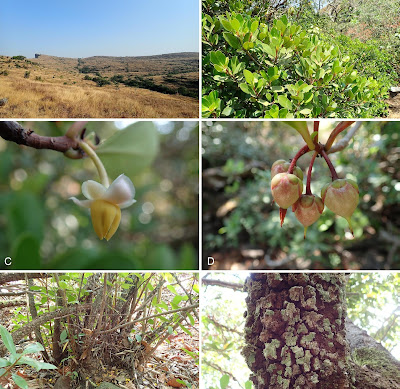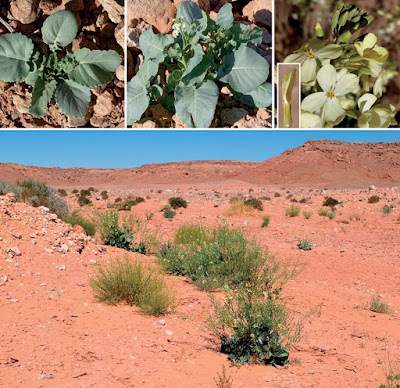[Most Recent Entries] [Calendar View]
Friday, December 13th, 2019
| Time | Event | ||||
| 4:05a | [Botany • 2019] Ternstroemia guineensis (Ternstroemiaceae) • A New Endangered Cloudforest Shrub with Neotropical Affinities from Kounounkan, Guinea, W Africa
Abstract Ternstroemia guineensis is described from a sandstone table mountain at Kounounkan, possibly the last in the Fouta Djallon (Guinea Highlands) to remain largely unimpacted by humans and to have mainly intact natural habitats. It occurs about 2400 km westward of the nearest existing record (Nigeria) of the genus in Africa. It is confined to cloud (submontane) forest in galleries along watercourses. Its conservation status is assessed as Endangered using the IUCN 2012 criteria. The species differs from the other two African highland species, T. cameroonensis and T. polypetala, in having hermaphrodite flowers with a long subcylindric style and punctiform stigmas, and petals connate at the base into a tube (not dioecious, with a short style and cone-like stigmas, and free petals) resembling in these features the neotropical Ternstroemia species, as does also the lowland wetland T. africana of Nigeria, Gabon and Angola. KEYWORDS: amphi-Atlantic, conservation, Guinea, Guinea Highlands, Kounounkan, medicinal, new species, Pentaphylacaceae, relic, Ternstroemia, Ternstroemiaceae, Theaceae, West Africa Holotype: Guinea, Forécariah Préfecture, S part of Kounounkan Plateau, ..., 910 m, fl., 26 Nov 2017, P. M. Haba with X. M. van der Burgt, L. Jennings & G. Konomou 1060 (K K001286639; isotypes: HNG, MO, P, US, WAG). Diagnosis — Similar to Ternstroemia africana Melch., differing in the smaller leaves (2.5–)3.7–6.1(–6.7) × (1.3–)1.6–2.5(–3) cm, secondary nerves not visible, (not (4–)8–10 × (2–)4–5 cm, secondary nerves visible, c. 7 pairs); petiole margins entire or with 1–2 setae (not densely glandular denticulate); peduncles 1.4–2.4 cm long (not 3–4.5 cm long). Distribution — Ternstroemia guineensis is currently only known from the southernmost plateau of the Kounounkan Massif in Forécariah Prefecture, an uninhabited sandstone table mountain, where it is known from gallery forests along four streams. Ecology — The species was found in species-rich submontane gallery (cloud) forest, on rocky soils, at 900–1100 m altitude. Etymology — The specific epithet guineensis signifies from Guinea (Guinea-Conakry or the Republic of Guinea), which holds the only known global location for this species. Martin Cheek, Pepe M. Haba, Gbamon Konomou and Xander M. Van Der Burgt. 2019. Ternstroemia guineensis (Ternstroemiaceae), A New Endangered Cloudforest Shrub with Neotropical Affinities from Kounounkan, Guinea, W Africa. Willdenowia. 49(3); 351-360. DOI: 10.3372/wi.49.49306 | ||||
| 4:11a | [Botany • 2019] Zahora ait-atta • A New Monotypic Genus from tribe Brassiceae (Brassicaceae) endemic to the Moroccan Sahara
Abstract Zahora ait-atta Lemmel & M.Koch, a new species from the Moroccan Sahara, is described and documented here and constitutes a monotypic new genus. The new taxon belongs to the tribe Brassiceae (Brassicaceae), and cytogenetic and phylogenetic analyses reveal that this diploid species has a remote status of Miocene origin in the northwestern Sahara Desert. We examined the morphological differences between morphologically related genera and provide photographs of the new species. The new genus may play a key role in future Brassica-Raphanus crop research since it is placed phylogenetically at the base of a generically highly diverse clade including Raphanus sativus, and it shows affinities to various Brassica species. Keywords: Brassiceae, Brassicaceae, flora of the Sahara, Morocco, new genus, Zahora ait-atta Type: Morocco. Meknés-Tafilalet/Drâa-Tafilalet: Border region with Algeria. Near Errachidia. Oued Bou-Ibourine, « Zizaou n´oudad », gps 31.4114, -3.7220, 900 m a.s.l., 11th March 2019, C. Lemmel s.n. (Holotype, HEID 505689; Isotype, G00394714, Conservatoire et jardin botanique de Genève; Paratype, HEID 505749, 505750, ex. cult. Botanical Garden Heidelberg 2019). Description: Herbs, woody at base, monocarpic, simple trichomes; rhizome fleshy, 2–3 cm in diam. Stems 80–140(-180) cm tall, robust, up to 1.4 cm in diam, erect, simple at base, often alternately branched in lower part. Basal leaves rosulate, fleshy; leaves lyrate, distal lobecordate, (10-)15–25(-40) cm, margin entire to distantly dentate, numerous simple trichomes on lower surface mostly along veins, upper side loosely covered with simple trichomes; cauline leaves similar but apex obtuse to weakly subacute, 10–15 × 5–7 cm. Raceme ebracteate, elongating in fruit, 40–100 cm; often branched. Sepals erect, saccate ca. 8 mm long, with few simple trichomes; petals pale-yellow,1.5–1.7 cm long, 6–7 mm wide, petal claw 8 mm long, obtuse at apex, glabrous. Filaments tetradynamous, ca. 9 mm long; nectar glands 4, rounded, elateral pair larger. Stigma entire. Infructescence with up to 100(-200) siliques, (30-)40–45(-48) mm, petiolate (9–11 mm). Fruits heteroarthrocarpic with a distal indehiscent balloon-like structure with two viable seeds (3.5–5 × 6–8 mm); proximal part dehiscent, terete (30–45 mm); 20–40 ovules; septum complete. Seeds biseriate, mucilaginous, 1.3–1.4 × 1.4–1.5 mm. Etymology: Zahora means “flower” in Arabic, indicating the attractive and peculiar appearance of the plant. “Aït-atta” are a Berber tribal confederation of south eastern Morocco who locally know the plant under the name «Zizaou n’oudad» (Barbary-sheep’s cabbage). Habitat: All places are in sandy beds of oueds flowing from the base of the kreb (cliff) of the Hamada du Guir or the Bin el Korbine. Ecology: Greenhouse and pollination experiments showed that the species is largely self-compatible. At its natural stands the plant is annual and monocarpic. However, in cultivation the plant species can be kept growing when cutting frutescence. There are two different options of seed release, either directly into a local soil seed bank from the dehiscent part of fruit or via the distal indehiscent part carrying two seeds, which may allow distributing effectively with water in the wadi systems at rare and occasional events.
Conclusion: Zahora ait-atta is described as a new species of a new monotypic genus. Zahora shows a peculiar fruit feature, namely heteroarthrocarpic fruits, and the species might mediate evolutionary between Core Oleracea clade (e.g. Brassica oleracea, Brassica napus) and Raphanus sativus and related genera. Both represent important crop plant groups with seeds playing an enormous agronomical role. The diploid new species might, therefore, serve as important germplasm reservoir to study traits and characters in a number of Brassiceae crop plants. |
| << Previous Day |
2019/12/13 [Calendar] |
Next Day >> |









